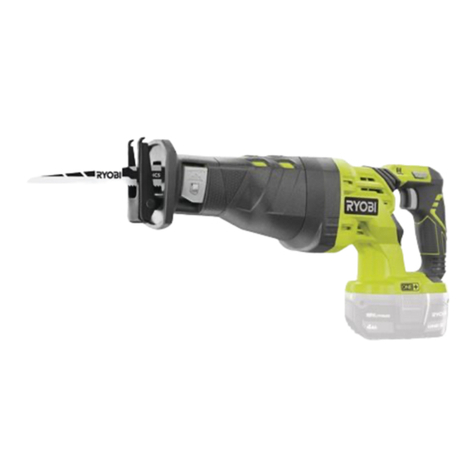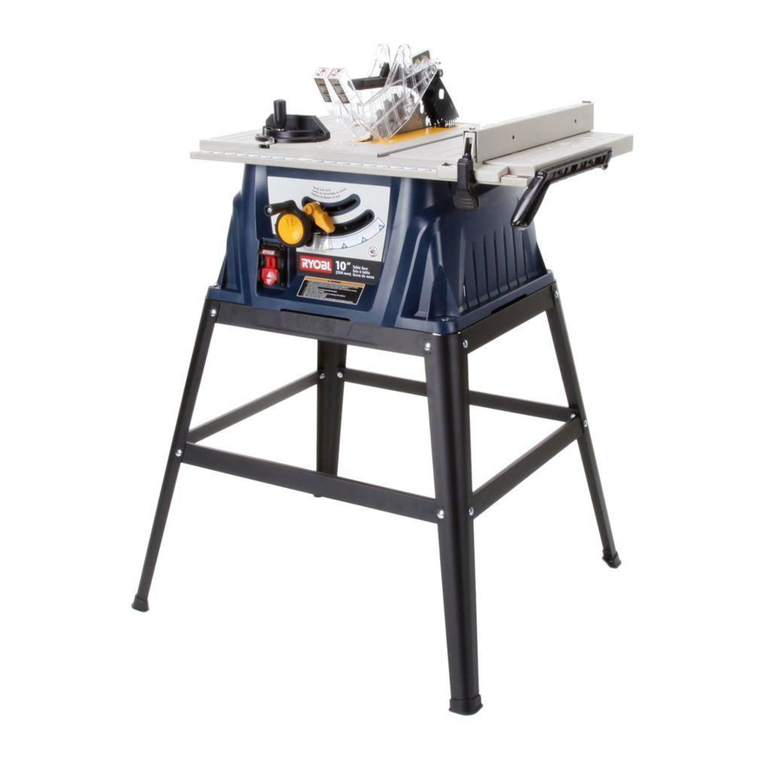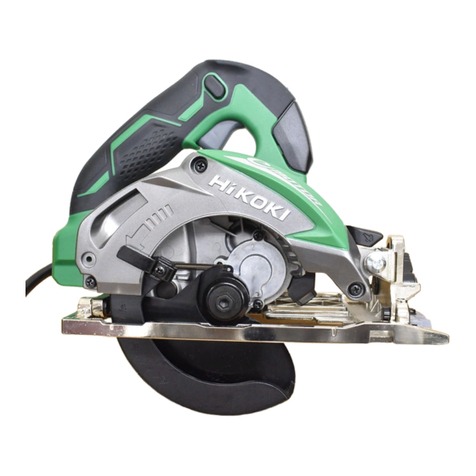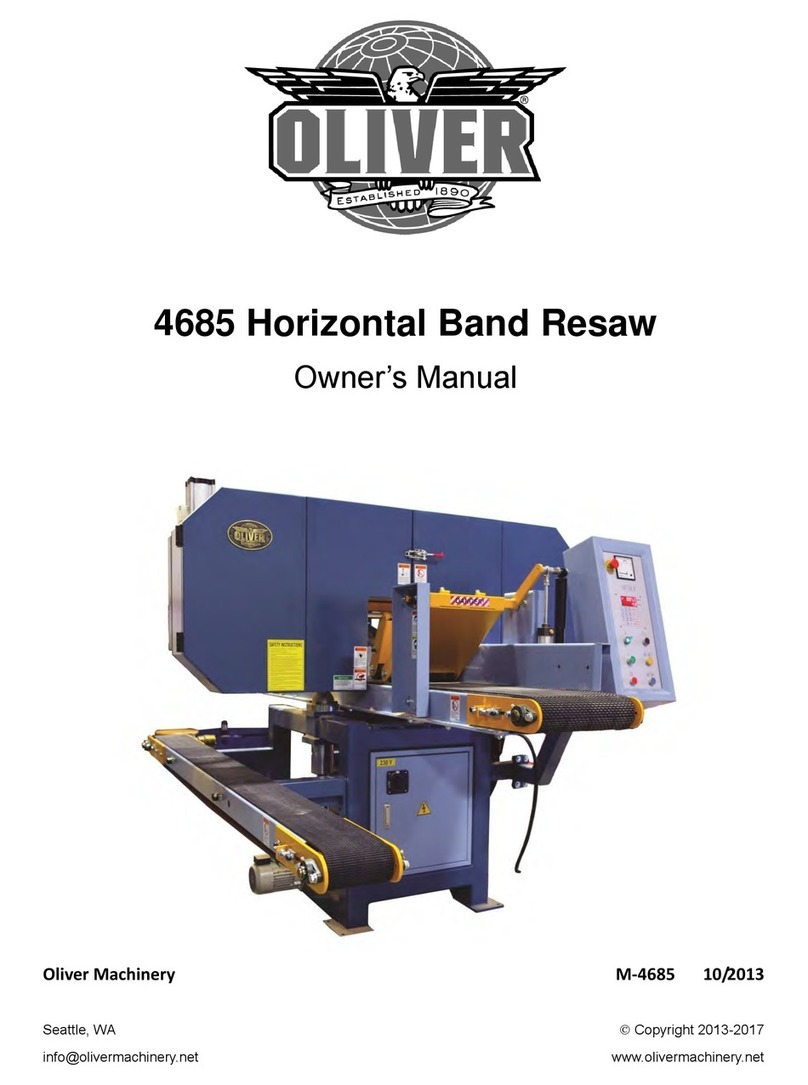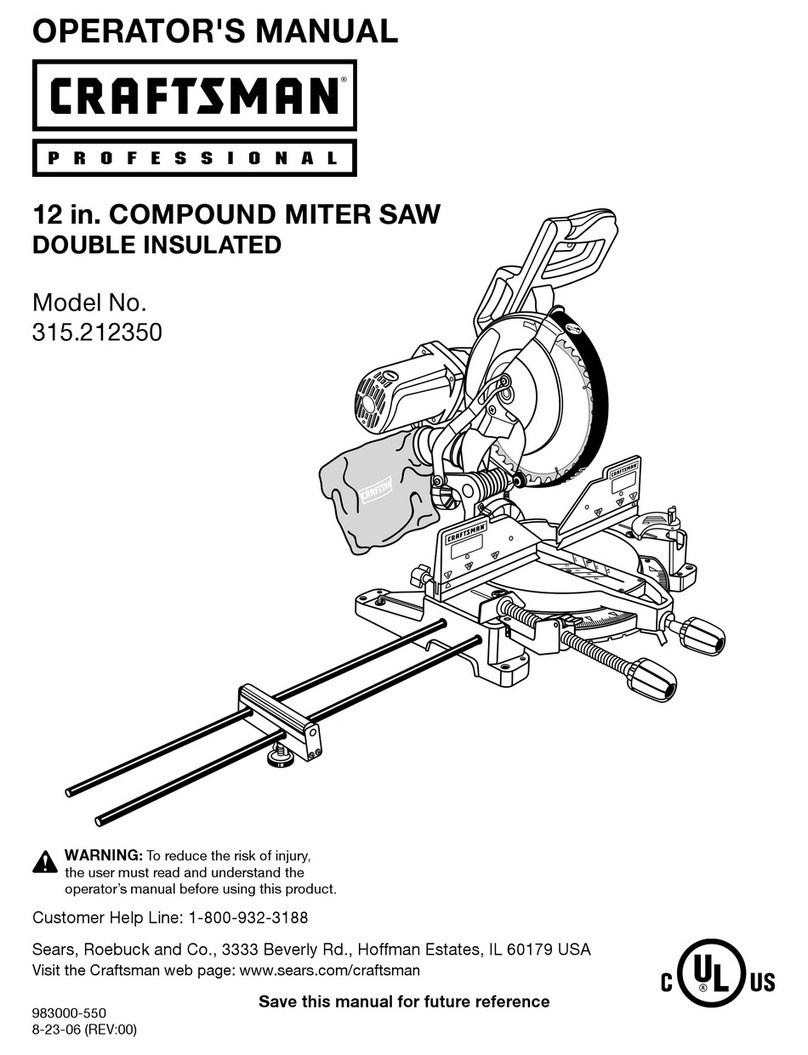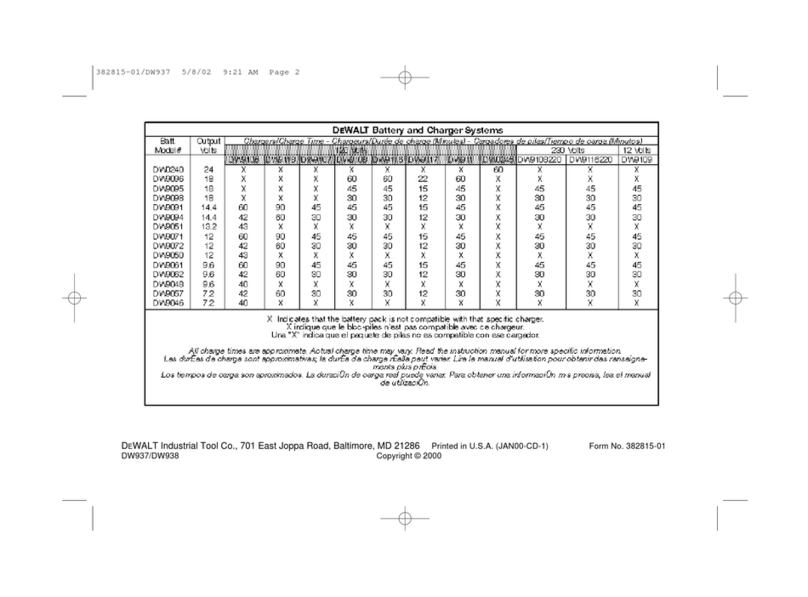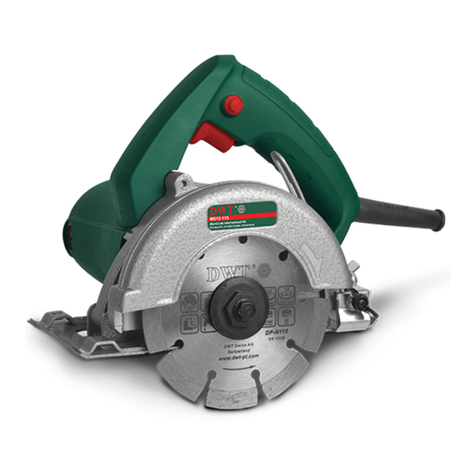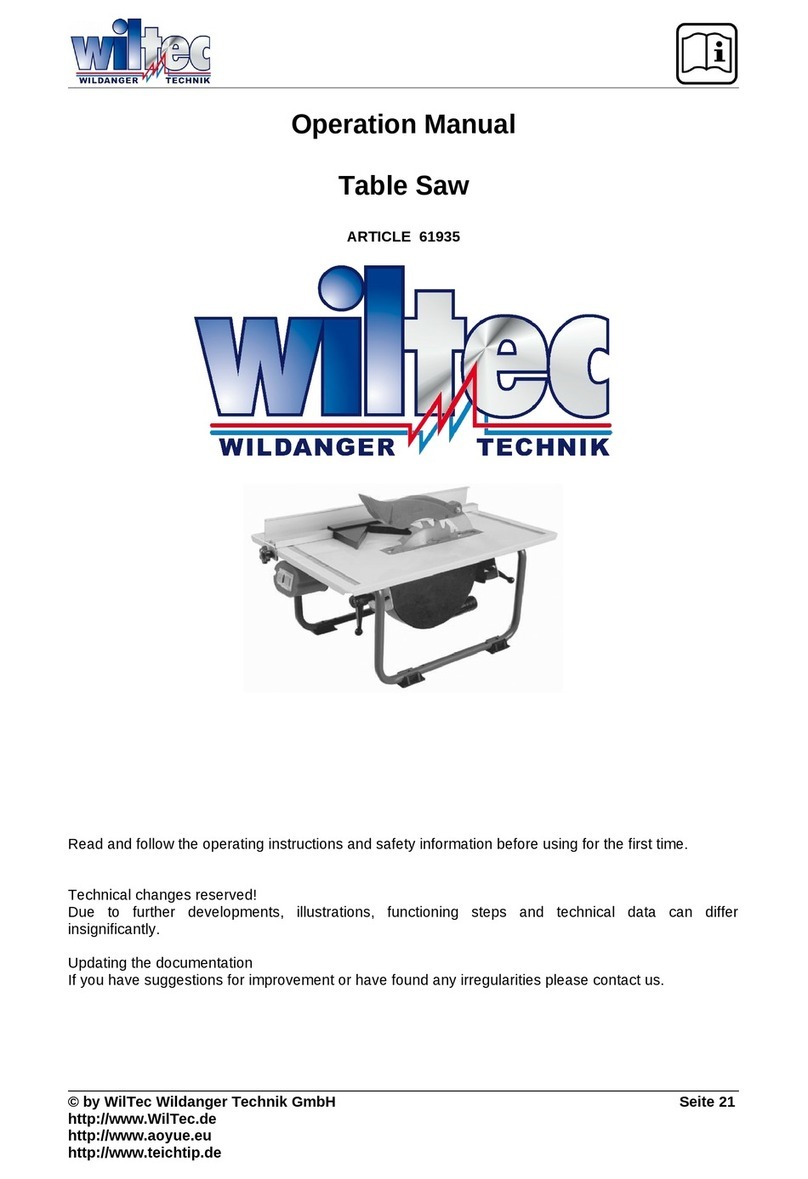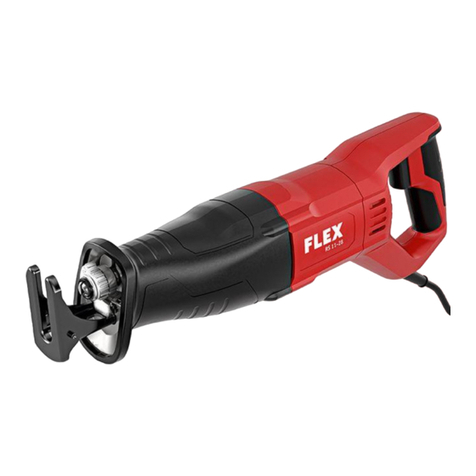Ryobi TS1301 User manual

OPERATOR'S MANUAL
10 in. (254 mm) Miter Saw
Model TS1301 - Double Insulated
THANK YOU FOR BUYING A RYOBI MITER SAW.
Your new saw has been engineered and manufactured to Ryobi's high standards for dependability, ease of operation, and
operator safety. Properly cared for, it will give you years of rugged, trouble-free performance.
CAUTION: Carefully read through this entire operator's manual before using your new saw.
Pay close attention to the Rules for Safe Operation, Warnings, and Cautions. If you use your saw properly and only for what
it is intended, you will enjoy years of safe, reliable service.
Please fill out and return the Warranty Registration Card so we can be of future service to you.
Thank you again for buying Ryobi tools.
12
2
3
3
4
4
5
5
8
8
SAVE THIS MANUAL FOR FUTURE REFERENCE

Page 2
Dust Guide ............................................................ 12
To Install Blade.................................................12-13
Dust Bag................................................................ 13
Table Extensions................................................... 14
Stop Block ............................................................. 14
Work Clamp (Optional).......................................... 15
Adjustments ............................................................. 15-17
Pivot Adjustments.................................................. 15
Travel Pivot Adjustment ........................................ 15
Squaring The Miter Table To The Fence .............. 16
Squaring The Saw Blade To The Fence ............... 17
Operation ..................................................................18-20
Applications ........................................................... 18
Cutting With Your Miter saw.................................. 18
Crosscutting .......................................................... 18
To Crosscut With Your Miter saw.......................... 18
Support Long Workpieces ..................................... 19
Cutting Warped Material........................................ 20
Clamping Wide Workpieces .................................. 20
Maintenance ............................................................. 21-22
General.................................................................. 21
Lubrication............................................................. 21
Extension Cords .................................................... 21
Brush Replacement............................................... 22
Troubleshooting............................................................ 23
Extension Cord Caution ............................................... 24
Parts Ordering / Service ............................................... 24
Table Of Contents ........................................................... 2
Safety and International Symbols ................................. 2
Rules For Safe Operation ............................................ 3-6
Additional Rules For Safe Operation For
Miter Saws ................................................................... 6
Product Specifications ................................................... 7
Glossary Of Terms For Woodworking .......................... 7
Unpacking And Checking Contents .............................. 8
Loose Parts List ........................................................... 8
Features ......................................................................9-11
Know Your Miter Saw.............................................. 9
14 Amp Motor.......................................................... 9
10 in. (254 mm) Blade ............................................. 9
Cutting Capacities ................................................... 9
Blade Wrench / Storage Area.................................. 9
Carrying Handle ...................................................... 9
Miter Lock Handle ................................................. 10
Spindle Lock Button .............................................. 10
Trigger Lock .......................................................... 10
Positive Stops On Miter Table............................... 10
Electric Brake ........................................................ 10
Fence .................................................................... 10
Self-Retracting Lower Blade Guard....................... 10
Mounting Holes ..................................................... 11
Optional Accessories............................................. 11
Electrical Connection............................................. 11
Assembly ..................................................................12-15
Miter Lock Handle ................................................. 12
TABLE OF CONTENTS
SAFETY AND INTERNATIONAL SYMBOLS
This operator's manual describes safety and international symbols and pictographs that may appear on this product.
Read the operator's manual for complete safety, assembly, operating and maintenance and repair information.
MEANING
• NO HANDS SYMBOL
Failure to keep your hands away from the blade will result
in serious personal injury.
• READ OPERATOR'S MANUAL
Failuretofollowoperatinginstructionsandsafetyprecautions
in operator's manual can result in serious injury. Read
operator's manual before starting or operating this unit.
SYMBOL

Page 3
The purpose of safety symbols is to attract your attention to possible dangers. The safety symbols, and the
explanations with them, deserve your careful attention and understanding. The safety warnings do not by
themselves eliminate any danger. The instructions or warnings they give are not substitutes for proper
accident prevention measures.
SYMBOL MEANING
SAFETY ALERT SYMBOL:
Indicatesdanger,warning,orcaution.Maybeusedinconjunctionwithothersymbolsorpictographs.
DANGER:Failuretoobeyasafetywarning willresultin seriousinjurytoyourselfortoothers.Always
follow the safety precautions to reduce the risk of fire, electric shock and personal injury.
WARNING:Failuretoobeyasafetywarningcanresultinseriousinjurytoyourselfortoothers.Always
follow the safety precautions to reduce the risk of fire, electric shock and personal injury.
CAUTION: Failure to obey a safety warning may result in property damage or personal injury to
yourselfortoothers.Alwaysfollowthesafetyprecautionstoreducetheriskoffire,electricshockand
personal injury.
NOTE: Advises you of information or instructions vital to the operation or maintenance of the equipment.
DOUBLE INSULATION
Double insulation is a concept in safety, in electric power
tools, which eliminates the need for the usual three-wire
grounded power cord. All exposed metal parts are isolated
from internal metal motor components with protecting
insulation.Doubleinsulatedtoolsdonotneedtobegrounded.
IMPORTANT
Servicing requiresextremecareandknowledgeandshould
be performed only by a qualified service technician. When
servicing, use only identical Ryobi replacement parts. For
service we suggest you return the tool to your nearest
RYOBIAUTHORIZEDSERVICECENTERforrepair.Call1-
800-525-2579 in the United State or visit our web site at
www.ryobitools.comforyournearestRYOBIAUTHORIZED
SERVICE CENTER.
WARNING:
The double insulated system is intended to protect the
user from shock resulting from a break in the tool's
internal wiring. Observe all normal safety precautions
related to avoiding electrical shock.
WARNING:
Do not attempt to operate this tool until you have read
thoroughly and understand completely all instructions,
safety rules, etc. contained in this manual. Failure to
comply can result in accidents involving fire, electric
shock, or serious personal injury. Save this operator's
manualandreviewfrequentlyforcontinuingsafeoperation
and instructing others who may use this tool.
RULES FOR SAFE OPERATION

Page 4
Safe operation of this power tool requires that you read and
understand this operator's manual and all labels affixed to
the tool. Safety is a combination of common sense, staying
alert, and knowing how your miter saw works.
READ ALL INSTRUCTIONS
1. KNOW YOUR POWER TOOL. Read the operator's
manual carefully. Learn the saw's applications and
limitations as well as the specific potential hazards
related to this tool.
2. GUARD AGAINST ELECTRICAL SHOCK BY
PREVENTING BODY CONTACT WITH GROUNDED
SURFACES. For example: pipes, radiators, ranges,
refrigerator enclosures.
3. KEEPGUARDS INPLACEandingoodworkingorder.
4. KEEP THE WORK AREA CLEAN. Cluttered work
areas and work benches invite accidents. DO NOT
leave tools or pieces of wood on the saw while it is in
operation.
5. DONOTUSEINDANGEROUSENVIRONMENTS.Do
not use power tools near gasoline or other flammable
liquids,indamporwetlocations,orexposethemtorain.
Keep the work area well lit.
6. KEEP CHILDREN AND VISITORS AWAY. All visitors
shouldwearsafetyglassesandbekeptasafedistance
from work area. Do not let visitors contact tool or
extension cord while operating.
7. MAKEWORKSHOPCHILDPROOFwithpadlocksand
master switches, or by removing starter keys.
8. DO NOT FORCE THE TOOL. It will do the job better
and safer at the rate for which it was designed.
9. USE THE RIGHT TOOL. Do not force the tool or
attachmenttodoajobitwasnotdesignedfor.Don'tuse
it for a purpose not intended.
10. DRESS PROPERLY. Do not wear loose clothing,
gloves, neckties, rings, bracelets, or other jewelry.
They can get caught and draw you into moving parts.
Nonslip footwear is recommended when working
outdoors. Also wear protective hair covering to contain
long hair.
11. ALWAYS WEAR SAFETY GLASSES WITH SIDE
SHIELDS. Everyday eyeglasses have only impact-
resistant lenses; they are NOT safety glasses.
12. PROTECT YOUR LUNGS. Wear a face or dust mask
if the cutting operation is dusty.
13. PROTECTYOURHEARING.Wearhearingprotection
during extended periods of operation.
14. DONOTABUSECORD.Neveryankcordtodisconnect
it from receptacle. Keep cord from heat, oil, and sharp
edges.
15. DO NOT OVERREACH. Keep proper footing and
balance at all times.
16. MAINTAINTOOLSWITHCARE.Keeptoolssharpand
clean for better and safer performance. Follow
instructions for lubricating and changing accessories.
17. DISCONNECT ALL TOOLS. When not in use, before
servicing, or when changing attachments, blades, bits,
cutters, etc., all tools should be disconnected.
18. REMOVEADJUSTINGKEYSANDWRENCHES. Get
in the habit of checking to see that hex keys and
adjustingwrenchesareremovedfromtoolbeforeturning
it on.
19. AVOID ACCIDENTAL STARTING. Be sure switch is
off when plugging in.
20. USE THE PROPER EXTENSION CORD. Make sure
yourextensioncordisingoodcondition.Whenusingan
extension cord, be sure to use one heavy enough to
carrythe current your product willdraw.An undersized
cordwill cause adrop in line voltageresulting in loss of
powerandoverheating.Awiregagesize(A.W.G.)ofat
least 14 is recommended for an extension cord 25 feet
or less in length. If in doubt, use the next heavier gage.
The smaller the gage number, the heavier the cord.
21. USE OUTDOOR EXTENSION CORDS. When tool is
usedoutdoors,useonlyextensioncordswithapproved
ground connection that are intended for use outdoors
and so marked.
22. KEEP BLADES CLEAN AND SHARP. Sharp blades
minimize stalling and kickback.
23. KEEP HANDS AWAY FROM CUTTING AREA. Keep
hands away from blades. Do not reach underneath
work or around or under the blade while blade is
rotating. Do not attempt to remove cut material when
blade is moving.
WARNING: Blades coast after turn off.
24. NEVER USE IN AN EXPLOSIVE ATMOSPHERE.
Normal sparking of the motor could ignite fumes.
25. INSPECT TOOL CORDS PERIODICALLY and if
damaged,haverepairedatyournearestAUTHORIZED
SERVICE CENTER. Stay constantly aware of cord
location and keep it well away from the rotating blade.
26. INSPECT EXTENSION CORDS PERIODICALLY and
replace if damaged.
27. KEEP TOOL DRY, CLEAN, AND FREE FROM OIL
ANDGREASE. Alwaysuseacleanclothwhencleaning.
Never use brake fluids, gasoline, petroleum-based
products, or any solvents to clean tool.
28. STAY ALERT AND EXERCISE CONTROL. Watch
what you are doing and use common sense. Do not
operate tool when you are tired. Do not rush.
RULES FOR SAFE OPERATION

Page 5
29. CHECK DAMAGED PARTS. Before further use of the
tool, a guard or other part that is damaged should be
carefullycheckedtodeterminethatitwilloperateproperly
and perform its intended function. Check for alignment
of moving parts, binding of moving parts, breakage of
parts,mountingandanyotherconditionsthatmayaffect
itsoperation.Aguardorotherpartthatisdamagedmust
beproperlyrepairedorreplacedbyanauthorizedservice
center to avoid risk of personal injury.
30. DO NOT USE TOOL IF SWITCH DOES NOT TURN IT
ON AND OFF. Have defective switches replaced by an
authorized service center.
31. USE THE FENCE. Alwaysusethe fence when cutting.
32. SUPPORT LONG WORKPIECES. To minimize risk of
blade pinching and kickback, always support long
workpieces.
33. BEFORE MAKING A CUT, BE SURE ALL
ADJUSTMENTS ARE SECURE.
34. USE ONLY CORRECT BLADES. Do not use blades
with incorrect size holes. Never use blade washers or
blade screws that are defective or incorrect. The
maximumbladecapacityofyoursawis10in.(254mm).
35. USE RECOMMENDED ACCESSORIES. The use of
improper accessories may cause risk of injury. Consult
operator's manual for recommended accessories.
36. NEVER STAND ON TOOL. Serious injury could occur
if the tool is tipped or if the blade is unintentionally
contacted.
37. POLARIZED PLUGS. To reduce the risk of electric
shock, this tool has a polarized plug (one blade is wider
thantheother).Thisplugwillfitinapolarizedoutletonly
oneway.Iftheplugdoesnotfitfullyintheoutlet,reverse
theplug.Ifitstilldoesnotfit,contactaqualifiedelectrician
toinstalltheproperoutlet.Donotchangethepluginany
way.
38. NEVER LEAVE TOOL RUNNING UNATTENDED.
TURN THE POWER OFF. Do not leave tool until it
comes to a complete stop.
39. TURN TOOL OFF AND WAIT FOR SAW BLADE TO
STOP BEFORE RAISING SAW HEAD, MOVING
WORK, OR CHANGING SETTINGS.
40. AVOID CUTTING NAILS. Inspect for and remove all
nails from lumber before cutting.
41. NEVER TOUCH BLADE or other moving parts during
use.
42. NEVER START A TOOL WHEN THE BLADE IS IN
CONTACT WITH THE WORKPIECE.
43. DO NOT OPERATE THIS TOOL WHILE UNDER THE
INFLUENCE OF DRUGS, ALCOHOL, OR ANY
MEDICATION.
44. SECURE WORK. Use clamps or a vise to hold work
when practical. It's safer than using your hand and it
frees both hands to operate tool.
45. REPLACEMENTPARTS.Allrepairs,whetherelectrical
or mechanical, should be made at your nearest
Authorized Service Center.
WARNING:
When servicing use only identical Ryobi replacement
parts. Use of any other parts may create a hazard or
cause product damage.
46. SAVE THESE INSTRUCTIONS. Refer to them
frequently and use them to instruct other users. If you
loan someone this tool, loan them these instructions
also.
Lookforthissymboltopointoutimportantsafetyprecautions.
It means attention!!! Your safety is involved.
WARNING:
RULES FOR SAFE OPERATION
The operation of any power tool can result in foreign objects being thrown into your eyes, which can
result in severe eye damage. Before beginning tool operation, always wear safety goggles or safety
glasses with side shields and a full face shield when needed. We recommend Wide Vision Safety
Mask for use over eyeglasses or standard safety glasses with side shields. Always wear eye
protection which is marked to comply with ANSI Z87.1.

Page 6
1. NEVER USE A DULL SAW BLADE or one that does
not have sufficient set.
2. DO NOT REMOVE THE SAW'S BLADE GUARDS.
Never operate the saw with any guard or cover re-
moved. Make sure all guards are operating properly
before each use.
3. MAKE SURE THE MITER TABLE IS LOCKED IN
POSITION BEFORE OPERATING YOUR SAW. Lock
the miter table by securely tightening the miter lock
handle.
4. NEVERPERFORMANYOPERATION"FREEHAND".
Alwaysplacetheworkpiecetobecutonthe miter table
and position it firmly against the fence as a backstop.
5. ALWAYS USE A CLAMP to secure the workpiece
when possible.
6. NEVER hand hold a workpiece that is too small to be
clamped. Keep hands clear of the no hands zone.
7. NEVERreachbehindorunder the blade and itscutting
path with your hands and fingers for any reason.
8. NEVER standor have any partofyour body in line with
the path of the saw blade.
9. ALLOWTHEMOTORTOCOMEUPTOFULLSPEED
before starting a cut.
10. ALWAYS release the power switch and allow the saw
blade to stop rotating before raising it out of the
workpiece.
11. NEVER reach to pick up a workpiece, a piece of scrap,
or anything else that is in or near the cutting path of the
blade.
12. NEVER leave the miter saw unattended while con-
nected to a power source.
13. FIRMLY CLAMP OR BOLT your miter saw to a work-
bench or table. The most comfortable saw table height
is 39 inches or at approximately hip height.
14. AVOID AWKWARD OPERATIONS AND HAND PO-
SITIONSwhereasuddenslipcouldcauseyourhandto
move into the blade. ALWAYS make sure you have
good balance. NEVER operate your miter saw on the
floor or in a crouched position.
15. ALWAYS PROVIDE ADEQUATE ROOM AND SUP-
PORT for crosscutting long workpieces.
16. NEVERUSEALENGTHSTOPONTHEFREESCRAP
END OF A CLAMPED WORKPIECE. NEVER hold
onto or bind the free scrap end of the workpiece in any
operation. If a work clamp and length stop are used
together, they must both be installed on the same side
of the saw table to prevent the saw from catching the
loose end and kicking up.
Additional Rules For Safe Operation
For Miter Saws
17. DO NOT TURN THE MOTOR SWITCH ON AND OFF
RAPIDLY. This could cause the saw blade to loosen
and could create a hazard. Should this ever occur,
stand clear and allow the saw blade to come to a
complete stop. Disconnect your saw from the power
supply and securely retighten the blade bolt.
18. NEVER cut more than one piece at a time. DO NOT
STACK more than one workpiece on the saw table at
a time.
19. IF ANY PART OF THIS MITER SAW IS MISSING or
should break, bend, or fail in any way, or should any
electrical component fail to perform properly, shut off
the power switch, remove the miter saw plug from the
power source and have damaged, missing, or failed
parts replaced before resuming operation.
20. ALWAYS STAYALERT!Donotallowfamiliarity(gained
from frequent use of your saw) to cause a careless
mistake. ALWAYS REMEMBER that a careless frac-
tion of a second is sufficient to inflict severe injury.
21. MAKESURETHEWORKAREAHASAMPLELIGHT-
ING to see the work and that no obstructions will
interfere with safe operation BEFORE performing any
work using your saw.
22. ALWAYS TURN OFF SAW before disconnecting it, to
avoid accidental starting when reconnecting to power
supply.
23. SAVE THESE INSTRUCTIONS. Refer to them fre-
quently and use to instruct other users. If you loan
someone this tool, loan them these instructions also.
SAVE THESE INSTRUCTIONS
WARNING:
Somedustcreatedbypowersanding,sawing,grinding,
drilling, and other construction activities contains
chemicals known to cause cancer, birth defects or
other reproductive harm. Some examples of these
chemicals are:
• lead from lead-based paints,
• crystalline silica from bricks and cement and other
masonry products, and
• arsenic and chromium from chemically-treated
lumber.
Your risk from these exposures varies, depending on
how often you do this type of work. To reduce your
exposure to these chemicals: work in a well ventilated
area, and work with approved safety equipment, such
asthosedustmasksthatarespeciallydesignedtofilter
out microscopic particles.

Page 7
Blade Diameter..................................................................................................................................10 in. (254 mm)
Blade Arbor ........................................................................................................................................5/8 in. (16 mm)
No Load Speed ........................................................................................................................................5,000 RPM
Rating ................................................................................................................................120 Volts, 60 Hz-AC Only
Input........................................................................................................................................................ 14 Amperes
Cutting Capacities:
At 90°: H x W
Max Width: 2-5/8" x 5-3/4"
Max Height: 3-1/4" x 3-1/2"
At 45°: H x W
Max Width: 2-3/4" x 4"
Max Height: 3-1/4" x 3-1/4"
Tool Weight ..................................................................................................................................28.2 lbs. (12.8 kg.)
Arbor
The shaft on which a blade or cutting tool is mounted.
Crosscut
A cutting or shaping operation made across the grain of the
workpiece.
Freehand
Performing a cut without using a fence, miter gage, fixture,
work clamp, or other proper device to keep the workpiece
from twisting during the cut.
Gum
A sticky, sap based residue from wood products.
Miter Cut
A cutting operation made with the wood at any angle other
than 90 degrees to the fence.
Resin
A sticky, sap base substance that has hardened.
Revolutions Per Minute (RPM)
The number of turns completed by a spinning object in one
minute.
Saw Blade Path
The area over, under, behind, or in front of the blade. As it
appliestotheworkpiece,thatareawhichwillbe,orhasbeen,
cut by the blade.
Set
Thedistancethatthetipofthesawbladetoothisbent(orset)
outward from the face of the blade.
Throw-Back
Throwing of a workpiece in a manner similar to a kickback.
Usually associated with a cause other than the kerf closing,
such as a workpiece not being against the fence, being
dropped into the blade, or being placed inadvertently in
contact with the blade.
Through Sawing
Any cutting operation where the blade extends completely
through the thickness of the workpiece.
Workpiece
The item on which the cutting operation is being done. The
surfaces of a workpiece are commonly referred to as faces,
ends, and edges.
No Hands Zone
Thearea between the markedlinesonthe left and rightside
of the miter table base. This zone is identified by no hands
zonelabelsplacedinsidethemarkedlinesonthemitertable
base. The operator's hands must stay clear of this area
during any operation of the saw.
PRODUCT SPECIFICATIONS
GLOSSARY OF TERMS FOR WOODWORKING
ESPECIFICACIONESSPECIFICATIONS

Page 8
Fig. 1
Your Miter Saw has been shipped completely assembled
except for the blade, miter lock handle, dust guide or dust
bag, table extensions, and stop block.
■Remove all loose parts from the carton. Separate and
check with the list of Loose Parts.
See Figure 1.
■Remove the packing materials from around your saw.
■Carefully lift saw from the carton and place it on a level
worksurface.Althoughsmall,thissawisheavy.Toavoid
back injury, get help when needed.
■Do not discard the packing materials until you have
carefullyinspectedthesaw,identifiedalllooseparts,and
satisfactorily operated your new saw.
■Your saw has been shipped with the saw arm locked in
thedownposition.Toreleasesawarm,pushdownontop
of saw arm and pull out the lock pin.
See Figure 3.
■Lift the saw arm by the handle. Hand pressure should
remain on the saw arm to prevent sudden rise upon
release of the lock pin.
■Examine all parts to make sure no breakage or damage
has occurred during shipping.
If any parts are damaged or missing, do not attempt to plug
in the power cord and turn the switch on until the damaged
or missing parts are obtained and are installed correctly.
Contactyour nearestRyobidealerorcall1-800-525-2579in
the United States for assistance if any parts are missing or
damaged.
WARNING:
If any parts are missing do not operate your saw until the
missing parts are replaced. Failure to do so could result
in possible serious injury.
LOOSE PARTS LIST
The following items are included with your Miter Saw:
■10 in. (254 mm) Blade
■Miter Lock Handle
■Dust Bag
■Dust Guide
■Stop Block
■Small Wing Screw (for use with stop block)
■Table Extensions (2)
■Clamp Bracket (2), (for use with table extensions)
■Clamp Bracket Screw (2), (for use with table extensions)
■Blade Wrench (1/4 in. Hey Key/Phillips Screwdriver)
■Operator's Manual
■Warranty Registration
Some models may include one or more of the following
accessories:
■Work Clamp
■8 mm Work Clamp Screw
SAW BLADE
MITER
LOCK HANDLE
BLADE WRENCH
UNPACKING AND CHECKING CONTENTS
DUST GUIDE
DUST BAG
TABLE EXTENSIONS
STOP BLOCK
CLAMP
BRACKET SCREWS
SMALL
WING SCREW
CLAMP BRACKETS

Page 9
Fig. 2
KNOW YOUR MITER SAW
See Figure 2.
Before attempting to use your saw, familiarize yourself with
all operating features and safety requirements.
WARNING:
Do not allow familiarity with your miter saw to make you
careless. Remember that a careless fraction of a second
is sufficient to inflict severe injury.
14 AMP MOTOR
Your saw has a powerful 14 amp motor with sufficient
power to handle tough cutting jobs. It is made with all ball
bearings, and has externally accessible brushes for ease
of servicing.
10 in. (254 mm) BLADE
A 10 in. (254 mm) saw blade is included with your miter
saw. It is fine for most wood cutting operations, but for fine
joinery cuts or cutting plastic, use one of the accessory
blades available from your nearest Ryobi dealer.
CUTTING CAPACITIES
When the miter angle (miter table) is set at 0°:
Your saw will cut dimensional lumber up to a 2 x 6.
When the miter angle (miter table) is set at 45°:
Your saw will cut dimensional lumber up to a 2 x 4.
BLADE WRENCH / STORAGE AREA
See Figure 2.
A blade wrench is packed with your saw. One end of the
wrenchisaphillipsscrewdriver and the other end is a 1/4 in.
(6.4 mm) hex key. Use the hex key end when installing or
removing blade and the phillips end when removing or
loosening screws. A storage area for the blade wrench is
located behind the fence.
CARRYING HANDLE
See Figure 3.
For convenience when carrying or transporting your miter
saw from one place to another, a carrying handle has been
provided on top of the saw arm as shown in figure 3. To
transport, turn off and unplug your saw, then lower the saw
arm and lock it in the down position. Lock saw arm by
depressing the lock pin. Tighten the miter lock handle.
Removethesawfromtheworkbench orworkstand.Itisnow
ready to transport.
FEATURES
WRENCH
STORAGE
AREA
BLADE
WRENCH
12
2
3458
LOWER
BLADE GUARD
DUST BAG
UPPER
BLADE GUARD
SAW ARM
FENCE
MITER TABLE
MITER SCALE
MITER
LOCK HANDLE
SWITCH
TRIGGER
NO HANDS
ZONE LABEL
MITER TABLE
BASE
CONTROL ARM
MITER
LOCK PLATE
"NO HANDS ZONE"
BOUNDARY LINE
POSITIVE STOP (S)
LOCK
PIN
CARRYING HANDLE
BLADE
TABLE
EXTENSION
STOP
BLOCK
TABLE
EXTENSION

Page 10
Fig. 3
Fig. 4
12345678
CARRYING
HANDLE
SAW ARM
LOCKED IN DOWN POSITION
SAW
ARM
MITER LOCK
HANDLE
PADLOCK
SWITCH
TRIGGER
LOCK
PIN
FEATURES
MITER LOCK HANDLE
See Figure 3.
The miter lock handle securely locks your saw at desired
miter angles.
SPINDLE LOCK BUTTON
See Figure 4.
A spindle lock button has been provided for locking the
spindle of your saw in a stationary position. Depress and
hold the spindle lock button while installing, changing, or
removing blade.
TRIGGER LOCK
See Figure 5.
To prevent unauthorized use of your miter saw, we suggest
that you disconnect it from the power supply and lock the
switch in the off position. To lock the switch, install a
padlock through the hole in the switch trigger. A lock with a
shackle between 1/4 in. (6.4 mm) and 19/64 in. (7.5 mm)
diameter may be used. When the lock is installed and
locked, the switch is inoperable. Store the padlock key in
another location.
POSITIVE STOPS ON MITER TABLE
Positive stops have been provided at 0°, 15°, 22-1/2°,
30°, and 45°. The 15°, 22-1/2°, 30°, and 45°positive
stops have been provided on both the left and right side
of the miter table.
ELECTRIC BRAKE
An electric brake has been provided to quickly stop blade
rotation after the switch is released.
FENCE
The fence on your miter saw has been provided as a
support to hold your workpiece securely against when
making all cuts.
SELF-RETRACTING LOWER BLADE GUARD
The lower blade guard is made of shock-resistant, see-
through plastic that provides protection from each side of
the blade. It retracts over the upper blade guard as the saw
is lowered into the workpiece.
SWITCH
TRIGGER
SPINDLE LOCK
BUTTON
Fig. 5

Page 11
Fig. 6
MOUNTING HOLE
See Figure 6.
Your miter saw should be mounted to a firm supporting
surface such as workbench. Four bolt holes have been
provided in the saw base for this purpose. Each of the four
mounting holes should be bolted securely using 3/8 in. (10
mm)machinebolts,lockwashers,andhexnuts(notincluded).
Boltsshouldbeofsufficient length to accommodate thesaw
base, lock washers, hex nuts, and the thickness of the
workbench.
Tighten all four bolts securely.
Theholepattern, shown in figure 6,isforan18 in. (457 mm)
x24in.(610mm)workbench.Carefullychecktheworkbench
after mounting to make sure that no movement can occur
duringuse.If anytipping,sliding,or walkingisnoted,secure
the workbench to the floor before operating.
OPTIONAL ACCESSORIES
Optional accessories, provided on some models, are avail-
able for use with your saw. They include table extensions, a
stop block, work clamp, and dust bag.
Table extensions increase the work surface to 36 in. (914
mm) wide, providing support for cutting long workpieces.
The stop block provides a stop for making repetitive cuts to
same length. It can be installed on either side of saw base.
The work clamp provides a means for clamping workpiece
securelyagainstthefencewhenmakingacut.Standard"C"
clamps can also be used for this purpose.
The dust bag catches sawdust, helping keep work area
cleaner.
If these accessories were not provided with our saw, they
are available from your Ryobi dealer. For the location of a
distributor near you, call 1-800-525-2579 in the United
States.
ELECTRICAL CONNECTION
Your saw has a precision built electric motor. It should be
connected to a power supply that is 120 volts, 60 Hz, AC
only(normalhouseholdcurrent). Donotoperatethis tool
ondirectcurrent(DC).Asubstantial voltage drop will cause
alossofpowerandthemotorwilloverheat.Ifyourtool does
not operate when plugged into an outlet, double-check the
power supply.
WARNING:
The operation of any saw can result in foreign objects
being thrown into your eyes, which can result in severe
eyedamage.Beforestartingpowertooloperation,always
wear safety goggles or safety glasses with side shields
andafullfaceshieldwhenneeded.Werecommendwide
vision safety mask for use over eyeglasses or standard
safety glasses with side shields.
WARNING:
Do not attempt to modify this tool or create accessories
not recommended for use with this tool. Any such alter-
ation or modification is misuse and could result in a
hazardous condition leading to possible serious per-
sonal injury.
FEATURES
22.5
5
3 .6
30
5
3 .6
4 5
4 5
MOUNTING SURFACE
TRACE HOLES
AT THESE LOCATIONS
FOR HOLE PATTERN
TRACE HOLES
AT THESE LOCATIONS
FOR HOLE PATTERN
SAW BASE

Page 12
Fig. 7
Fig. 9
Restore lower blade
guard andsecurely
tightenscrew
before use.
DUST GUIDE
UPPER
BLADE GUARD
EXHAUST
PORT
6
78
12
345678
WARNING:
To prevent accidental starting that could cause possible
seriouspersonalinjury,assembleallparts,makesureall
adjustments are complete, and make sure all fasteners
are secure before connecting saw to power supply. Saw
shouldneverbeconnectedtopowersupplywhenyouare
assembling parts, making adjustments, installing or re-
moving blades, or when not in use.
As mentioned previously your saw has been factory as-
sembled and adjusted. The miter lock handle, dust guide or
dust bag, table extensions, stop block, and blade are the
only parts that have to be installed.
MITER LOCK HANDLE
See Figure 7.
To install the miter lock handle, place the threaded stud on
the end of the miter lock handle into the threaded hole in
the control arm under miter table. Turn clockwise to tighten.
DUST GUIDE
See Figure 8.
To install the dust guide, place the end marked INSERT
over the exhaust port in the upper blade guard. Turn the
guide so that the open end is facing down.
TO INSTALL BLADE
See Figures 9, 10, and 11.
WARNING:
A 10 in. (254 mm) blade is the maximum blade capacity
of your saw. Never use a blade that is too thick to allow
outerbladewashertoengagewiththeflatsonthespindle.
Largerblades will comeincontact with the bladeguards,
while thicker blades will prevent the blade bolt from
securing the blade on the spindle. Either of these situa-
tions could result in a serious accident and can cause
serious personal injury.
■Unplug your saw.
WARNING:
Failure to unplug your saw could result in accidental
starting causing possible serious personal injury.
■Insert the wrench provided through slot in lower blade
guard bracket and loosen screw A, securing the blade
bolt cover, approximately one-half turn.
See Figure 9.
■Rotate lower blade guard up and remove screw B. Ro-
tate blade bolt cover up and back to expose the blade
bolt.
■Push down on the saw arm and pull out the lock pin to
release saw arm. Raise saw arm to its full raised posi-
tion. Be cautious, saw arm is spring loaded to raise.
TO
TIGHTEN
CONTROL ARM TO
LOOSEN
MITER
LOCK HANDLE
ASSEMBLY
SLOT SCREW A SCREW B
12345678
a
a
a
a
a
a
a
a
a
a
a
a
a
a
a
a
aa
aaa
a
a
Restore lower blade
guard andsecurely
tightenscrew
before use.
ROTATE SAW ARM UP
TO EXPOSE SCREW B
ROTATE SAW ARM DOWN
TO EXPOSE SCREW A
MITER
TABLE
Restore lower blade
guard and securely
tighten screw
before use.
Fig. 8

Page 13
a
a
a
a
a
a
a
aa
a
aa
a
a
a
a
a
a
a
aa
Restore lower blade
guard and securely
tighten screw
before use.
■Depress the spindle lock button and rotate the blade
bolt until the spindle locks.
See Figure 10.
■Using the wrench provided, loosen and remove the blade
bolt.
NOTE: The blade bolt has left hand threads. Turn blade
bolt clockwise to loosen.
■Remove outer blade washer. Do not remove inner blade
washer.
■Wipe a drop of oil onto inner blade washer and outer
blade washer where they contact the blade.
WARNING:
Ifinnerbladewasherhasbeenremoved,replaceitbefore
placing blade on spindle. Failure to do so could cause an
accident since blade will not tighten properly.
■Fit saw blade inside lower blade guard and onto spindle.
The blade teeth point downward at the front of saw as
shown in figure 11.
CAUTION:
Alwaysinstallthebladewiththebladeteethandthearrow
printed on the side of the blade pointing down at the front
ofthesaw.Thedirectionofbladerotationisalsostamped
with an arrow on the upper blade guard.
■Replace outer blade washer. The double "D" flats on the
blade washers align with the flats on the spindle.
■Depress spindle lock button and replace blade bolt.
NOTE: The blade bolt has left hand threads. Turn blade
bolt counterclockwise to tighten.
■Tighten blade bolt securely.
■Replace the lower blade guard and blade bolt cover.
■Replace screw B and tighten securely.
■Retighten screw A securely.
■Replace wrench in storage area.
WARNING:
Make sure the spindle lock button is not engaged before
reconnecting saw into power source. Never engage
spindle lock button when blade is rotating.
DUST BAG
See Figure 12.
A dust bag is provided for use on your miter saw. It fits over
the exhaust port on the upper blade guard. To install it,
remove dust guide from exhaust port. Then, squeeze the two
metal clips to open the mouth of the bag and slide it on the
exhaust port. Release the clips. The metal ring in the bag
should lock in between the grooves on the exhaust port.
To remove the dust bag for emptying, simply reverse the
above procedure.
ASSEMBLY
Fig. 10
Fig. 11
LOWER
BLADE
GUARD
BLADE
BOLT COVER
OUTER BLADE WASHER
WITH DOUBLE "D" FLATS
BLADE
BLADE BOLT
TO
LOOSEN
TO
TIGHTEN
SWITCH
TRIGGER
SPINDLE LOCK
BUTTON
a
a
a
a
a
a
a
aa
a
aa
aaa
a
a
a
a
a
a
a
aa
a
a
a
a
a
a
a
a
a
a
aa
a
aa
aa
a
a
a
a
a
a
a
a
aa
a
a
aa
a
a
a
a
a
aa
aa
a
a
a
a
a
a
a
a
a
a
a
a
a
a
a
a
a
a
a
aa
a
aa
aaa
a
a
a
a
a
a
a
aa
a
a
aa
a
a
a
a
a
a
a
a
a
a
a
a
a
a
a
a
a
a
a
a
a
45678
a
a
a
a
aa
a
a
aa
a
aa
a
aa
a
a
a
a
aa
a
a
a
a
a
aa
a
a
aaa
a
a
a
a
aaa
a
a
a
aa
a
a
a
aaaaa
a
a
a
a
a
aa
a
a
a
a
a
a
a
a
a
a
a
aa
aa
a
a
aa
a
a
a
a
a
a
a
aa
a
a
a
a
aaa
a
a
a
a
a
a
a
a
a
a
a
a
DUST BAG
METAL CLIPS
EXHAUST
PORT
Fig. 12
Restore lower blade
guard and securely
tighten screw
before use.
FLAT (S)
ON SPINDLE

Page 14
TABLE EXTENSIONS
See Figures 13, 14, and 15.
If you plan to use the stop block, slide the stop block on the
back arm of the desired table extension first.
See Figure 13.
To install table extensions, insert the ends of extensions into
the holes in the sides of the base.
See Figures 13 and 14.
Adjust the extensions to the desired length.
Secure them in place by positioning a clamp bracket under
each table extension beneath the miter table. Orient each
clamp bracket as shown in figure 15.
Secure each clamp bracket in place with a clamp bracket
screw. The clamp bracket screw threads through the clamp
bracket and tightens against bracket support on bottom of
miter table, securing clamp bracket against table extension.
STOP BLOCK
See Figures 13 and 16.
The stop block is included with the Table extensions and is
useful as a stop for making repetitive cuts to the same
length. It can be installed on either side of the saw base:
■Slide the stop block on the back arm of either table
extension, then insert the table extensions into the saw
base.
See Figure 13.
■Use the small wing screw to secure the stop block to the
table extensions.
See Figure 13.
■Loosen the small wing screw and adjust the stop block
the desired distance from the blade for the cut to be
made. For accurate placement of the stop block, mea-
sure the distance from the teeth set on the blade to the
stop block.
■Tighten wing screw securely.
■Make a test cut in scrap material and measure the
length of the workpiece.
■Make any necessary adjustments.
WARNING:
Alwaysmakesure your miter saw issecurelymountedto
a workbench or an appropriate workstand. Failure to do
socouldresultinanaccidentresultinginpossibleserious
personal injury.
ASSEMBLY
Fig. 13
Fig. 14
Fig. 15
Fig. 16
CLAMP
BRACKET SCREW
MITER
SAW BASE
SAW VIEWED FROM BOTTOM
1
STOP BLOCK
SMALL
WING SCREW
MITER
SAW BASE
TABLE
EXTENSION
TABLE
EXTENSION
CLAMP
BRACKET
CLAMP
BRACKET
ASSEMBLED
STOP BLOCK
a
a
a
a
a
a
a
a
a
a
a
a
a
a
a
a
a
a
a
a
aa
aa
a
a
a
a
a
a
aa
a
aa
a
a
a
a
a
a
a
a
a
a
a
a
a
a
123
3
4
4
5
5
8
8
TABLE
EXTENSION
a
a
a
a
a
a
a
aa
a
aa
aaa
a
a
a
a
a
a
a
aa
a
a
a
a
a
a
a
a
a
a
aa
a
aa
aa
a
a
a
a
a
a
a
a
aa
a
a
aa
a
a
a
a
a
aa
aa
a
a
a
a
a
a
a
a
a
a
a
a
a
a
a
a
a
a
a
aa
a
aa
aaa
a
a
a
a
a
a
a
aa
a
a
aa
a
a
a
a
a
a
a
a
a
a
a
a
a
a
a
a
a
a
a
a
a
12
23
34
45
58
8
a
a
a
a
BRACKET
SUPPORT
MITER
SAW BASE

Page 15
ADJUSTMENTS
ASSEMBLY
WARNING:
Before connecting saw to power source, make sure the
sawblade or bladeguardwill not hitthetable extensions
or work clamp when cutting 35°to 45°angles.
WORK CLAMP (Optional)
Whether using a C-Clamp or the optional work clamp, part
number 982021-001, available for your saw, they provide a
means of clamping the work to the fence or table. Clamp-
ing secures the work and prevents the workpiece from
creeping toward the saw blade. This is very helpful when
cutting miters.
WARNING:
When using any clamp with the stop block, install the
clamp on the same side as the stop block. This will
eliminatethepossibilityoftrappingtheworkpiece,resulting
in the saw blade and workpiece kicking up. Failure to
heed this warning can result in serious personal injury.
NOTE: Many of the illustrations in this manual show only
portions of your miter saw. This is intentional so that we
can clearly show points being made in the illustrations.
Never operate your saw without all guards securely in
place and in good operating condition.
PIVOT ADJUSTMENTS
NOTE: These adjustments were made at the factory and
normally do not require readjustment.
TRAVEL PIVOT ADJUSTMENT
■The saw arm should rise completely to the up position
by itself.
■If the saw arm does not raise by itself or if there is play in
the pivot joints, have saw repaired at your nearest RYOBI
AUTHORIZED SERVICE CENTER.
Your Ryobi miter saw has been adjusted at the factory for
making very accurate cuts. However, some of the compo-
nents might have been jarred out of alignment during ship-
ping. Also, over a period of time, readjustment will probably
become necessary due to wear. After unpacking your saw,
check the following adjustments before you begin using
saw. Make any readjustments that are necessary and peri-
odically check the parts alignment to make sure that your
saw is cutting accurately.
WARNING:
Your saw should never be connected to power supply
when you are assembling parts, making adjustments,
installingorremovingblades,orwhennotinuse.Discon-
necting your saw will prevent accidental starting that
could cause serious injury.

Page 16
22.5
5
3.6
30
5
3 .6
4 5
4 55
Fig. 19
Fig. 20
SOCKET
HEAD SCREW(S)
SOCKET
HEAD SCREW(S)
8
7
6
5
4
3
2
1
8
7
6
5
4
3
2
1
SQUARING THE MITER TABLE TO THE FENCE
See Figures 17 - 20.
■Unplug your saw.
WARNING:
Failure to unplug your saw could result in accidental
starting causing possible serious personal injury.
■Push down on the saw arm and pull out the lock pin to
release the saw arm.
See Figure 3.
■Raise saw arm to its full raised position.
■Loosen the miter lock handle approximately one-half
turn.
■Depress the miter lock plate and rotate the miter table
until the pointer on the control arm is positioned in the
positive stop at 0°.
■Release the miter lock plate and securely tighten the
miter lock handle.
■Lay a framing square flat on the miter table. Place one
leg of the square against the fence. Place the other leg
of the square beside the blade slot in the miter table.
The edge of the square and the blade slot in the miter
table should be parallel as shown in figure 17.
■If the edge of the framing square and the blade slot in
the miter table are not parallel as shown in figures 18
and 19, adjustments are needed.
■Using the wrench provided, loosen the socket head
screws securing the fence.
See Figure 20.
Adjust the
fence left or right until the framing square and blade slot
are parallel.
■Retighten the screws securely and recheck the fence-
to-table alignment.
FENCE MITER TABLE
BLADE SLOT
FRAMING
SQUARE
VIEW OF MITER TABLE NOT SQUARE WITH
FENCE, ADJUSTMENTS ARE REQUIRED
ADJUSTMENTS
Fig. 18
VIEW OF MITER TABLE NOT SQUARE WITH
FENCE, ADJUSTMENTS ARE REQUIRED
MITER TABLE
BLADE SLOT
FENCE
FRAMING
SQUARE
FENCE
MITER
LOCK HANDLE
BLADE SLOT
MITER TABLE
MITER
LOCK PLATE
FRAMING
SQUARE
FENCE
VIEW OF MITER
TABLE SQUARE WITH FENCE Fig. 17
8
7
6
5
4
3
2
1

Page 17
SQUARING THE SAW BLADE TO THE FENCE
See Figures 21 - 24.
■Unplug your saw.
WARNING:
Failure to unplug your saw could result in accidental
starting causing possible serious personal injury.
■If saw is mounted to a workbench, it must be unmounted
to square the saw blade to the fence.
■Pull the saw arm all the way down and engage the lock pin
to hold the saw arm in transport position.
See Figure 3.
■Place saw on a large, stable work surface.
■Loosen the miter lock handle approximately one-half turn.
■Position saw in tilted position as shown in figure 24, to
locate the two socket head screws under the miter table.
CAUTION:
Topreventlossofcontrolofyoursaw,holdsawbasewith
one hand while loosening the socket head screws with
your other hand.
■Using a 10 mm hex key, loosen the two socket head screws.
■Reposition saw to its normal operating position.
■Lay a framing square flat on the miter table. Place one
leg of the square against the fence. Slide the other leg of
the square against the flat part of saw blade.
NOTE: Make sure that the square contacts the flat part
of the saw blade, not the blade teeth.
■The edge of the square and the saw blade should be
parallel as shown in figure 21.
■If the front or back edge of the saw blade angles away
from the square as shown in figures 22 and 23, adjust-
ments are needed.
■Using the miter lock handle, move the miter table left or
right until the saw blade is parallel to the square.
■Position saw in tilted position as shown in figure 24 and
tighten the two socket head screws securely.
■Reposition saw to its normal operating position.
■Recheck the fence-to-table alignment.
ADJUSTMENTS
NOTE: After squaring adjustments have been made, it
may be necessary to loosen the scale indicator screw and
reset the indicator to zero.
Fig. 22
FENCE
VIEW OF BLADE NOT SQUARE WITH
FENCE, ADJUSTMENTS ARE REQUIRED
FENCE
BLADE
FRAMING
SQUARE
BLADE
MITER
TABLE
MITER
TABLE
VIEW OF BLADE NOT SQUARE WITH
FENCE, ADJUSTMENTS ARE REQUIRED
FRAMING
SQUARE
SOCKET
HEAD SCREWS
MITER LOCK
HANDLE
BLADE
MITER
LOCK HANDLE
MITER
LOCK PLATE
FENCE
FRAMING
SQUARE
MITER
TABLE
VIEW OF BLADE
SQUARE WITH FENCE Fig. 21
Fig. 23
SCALE
INDICATOR
SCALE INDICATOR
SCREW
Fig. 24
SAW BASE SHOWN TILTED
UP TO LOCATE SCREWS

Page 18
12
2
3
3
4
4
5
5
6
6
7
7
8
8
STRAIGHT CROSSCUT Fig. 25
WARNING:
Before starting any cutting operation, clamp or bolt your
miter saw to a workbench. Never operate your miter saw
onthefloor orinacrouched position.Failureto heedthis
warning can result in serious personal injury.
CUTTING WITH YOUR MITER SAW
WARNING:
When using a work clamp or C-clamp to secure your
workpiece against the fence, clamp workpiece on one
sideofthebladeonly.Theworkpiecemustremainfreeon
one side of the blade to prevent the blade from binding in
workpiece. The workpiece binding the blade will cause
motorstallingandkickback.Thissituationcouldcausean
accident resulting in possible serious personal injury.
CROSSCUTTING
See Figure 25.
A crosscut is made by cutting across the grain of the
workpiece. A straight crosscut is made with the miter table
set at the zero degree position. Miter crosscuts are made
with the miter table set at some angle other than zero.
TO CROSSCUT WITH YOUR MITER SAW:
■Pull out the lock pin and lift saw arm to its full height.
■Loosen the miter lock handle. Rotate the miter lock
handle approximately one-half turn to the left to loosen.
■Pressthemiterlockplatedownwithyourthumbandhold.
■Rotate the control arm until the pointer aligns with the
desired angle on the miter scale.
■Release the miter lock plate.
NOTE: You can quickly locate 0°, or 15°, 22-1/2°, 30°,
and45°leftorrightbyreleasingthemiterlockplateasyou
rotate the control arm. The miter lock plate will seat itself
in one of the positive stop notches, located in the miter
table frame.
■Tighten the miter lock handle securely.
OPERATION
WARNING:
Toavoidserious personalinjury,alwaystighten themiter
lockhandlesecurelybeforemakingacut.Failuretodoso
couldresultinmovementofthecontrol arm or miter table
while making a cut.
■Place the workpiece flat on the miter table with one edge
securely against the fence. If the board is warped, place
theconvexside against the fence. If theconcaveedgeof
a board is placed against the fence, the board could
collapse on the blade at the end of the cut, jamming the
blade.
See Figures 27 and 28.
■When cutting long pieces of lumber or molding, support
the opposite end of the stock with a roller stand or with a
work surface level with the saw table.
See Figure 25.
■Align cutting line on the workpiece with the edge of saw
blade.
■Graspthestockfirmlywithonehandandsecureitagainst
thefence. UsetheworkclamporaC-clamptosecurethe
workpiece when possible.
WARNING:
Toavoidseriouspersonalinjury,keepyourhandsoutside
thenohandszoneandatleast3in.(76.2mm)fromblade.
Never perform any cutting operation freehand (without
securing workpiece against the fence). The blade could
grab the workpiece if it slips or twists.
APPLICATIONS
(Use only for the purposes listed below)
■Cross cutting wood and plastic.
■Cross cutting miters, joints, etc. for picture frames,
moldings, door casings, and fine joinery.
NOTE: The crosscut blade provided is fine for most wood
cutting operations, but for fine joinery cuts or cutting plastic,
use one of the accessory blades available from your Ryobi
dealer.

Page 19
Fig. 26
LONG WORKPIECE
WORKPIECE SUPPORTS
12
345678
SUPPORT LONG WORKPIECES
See Figure 26.
Long workpieces need extra supports. Supports should be
placed along the workpiece so it does not sag. The support
should let the workpiece lay flat on the base of the saw and
work table during the cutting operation. Use the work clamp
or a C-clamp to secure the workpiece.
OPERATION
WARNING:
Toavoidseriouspersonalinjury,alwayskeepyourhands
outside the no hands zone and at least 3 in. (76.2 mm)
fromblade.Neverperformanycuttingoperationfreehand
(without securing workpiece against the fence). The
blade could grab the workpiece if it slips or twists.
■Beforeturningonthesaw,performadryrunofthecutting
operation just to make sure that no problems will occur
when the cut is made.
■Grasp the saw handle firmly then squeeze the switch
trigger. Allow several seconds for the blade to reach
maximum speed.
■Slowly lower the blade into and through the workpiece.
■Releasetheswitchtriggerandallowthesawbladetostop
rotating before raising the blade out of workpiece. Wait
until the electric brake stops blade from turning before
removing the workpiece from the miter table.

Page 20
12
345678
CUTTING WARPED MATERIAL
See Figures 27 and 28.
When cutting warped material, always make sure it is
positionedonthemitertablewiththeconvexsideagainstthe
fence as shown in figure 27.
Ifthewarpedmaterial ispositionedthewrongwayas shown
in figure 28, it will pinch the blade near the completion of the
cut.
WARNING:
Toavoida kickbackandtoavoid seriouspersonal injury,
never position the concave edge of bowed or warped
material against the fence.
CLAMPING WIDE WORKPIECES
See Figure 29.
When cutting wide workpieces that are too wide to be
clamped with a work clamp, a C-clamp must be used. For
example, when cutting 2 in. x 6 in. boards, they should be
clamped with a C-clamp as shown in figure 29.
OPERATION
Fig. 27
Fig. 28
Fig. 29
RIGHT
WRONG
WIDE
BOARD
C-CLAMP
22.5
5
3 .6
30
5
3 .6
4 5
4 5
5
22.5
5
3.6
30
5
3.6
4 5
4 5
5
Table of contents
Other Ryobi Saw manuals
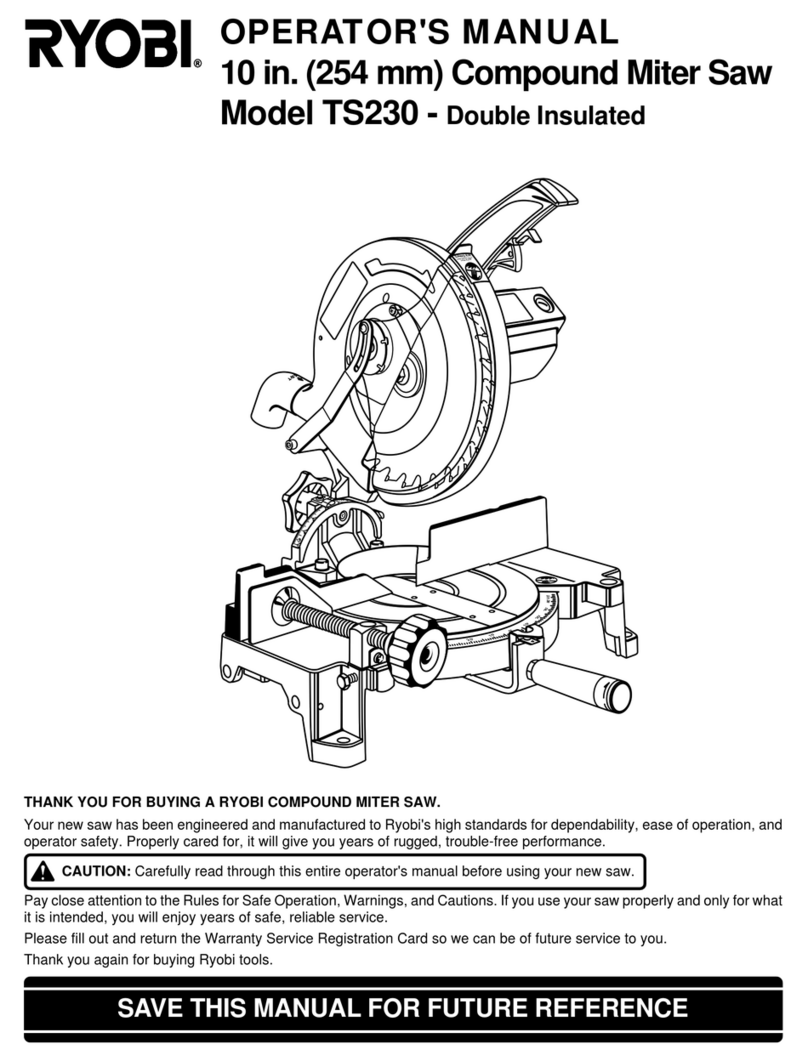
Ryobi
Ryobi TS230 User manual
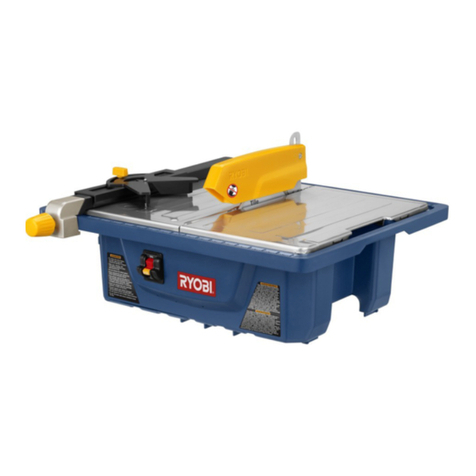
Ryobi
Ryobi WS721 User manual
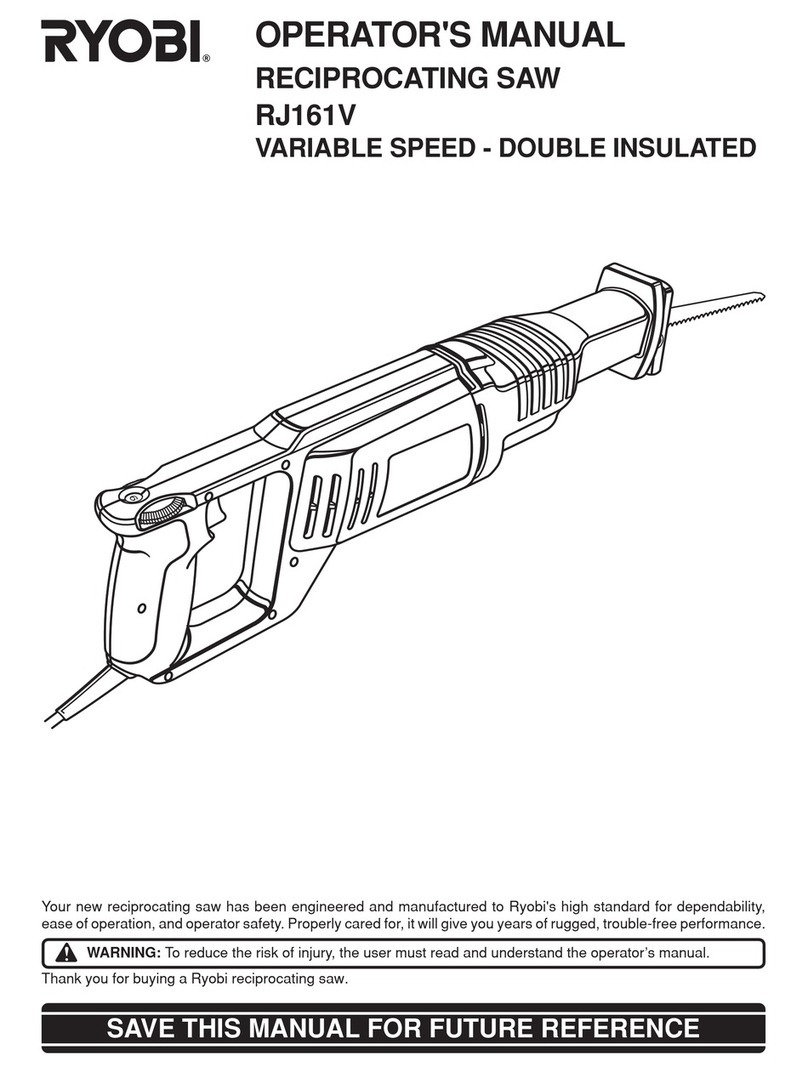
Ryobi
Ryobi RJ161V User manual
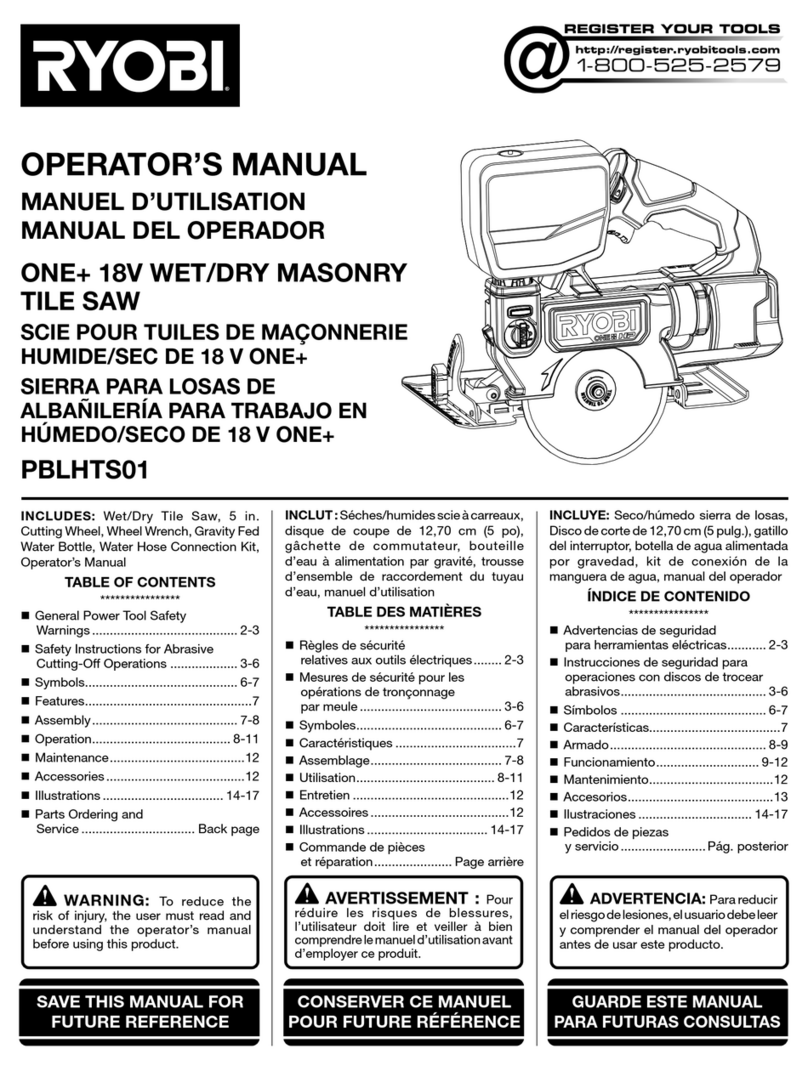
Ryobi
Ryobi PBLHTS01 User manual

Ryobi
Ryobi RRS18X User manual
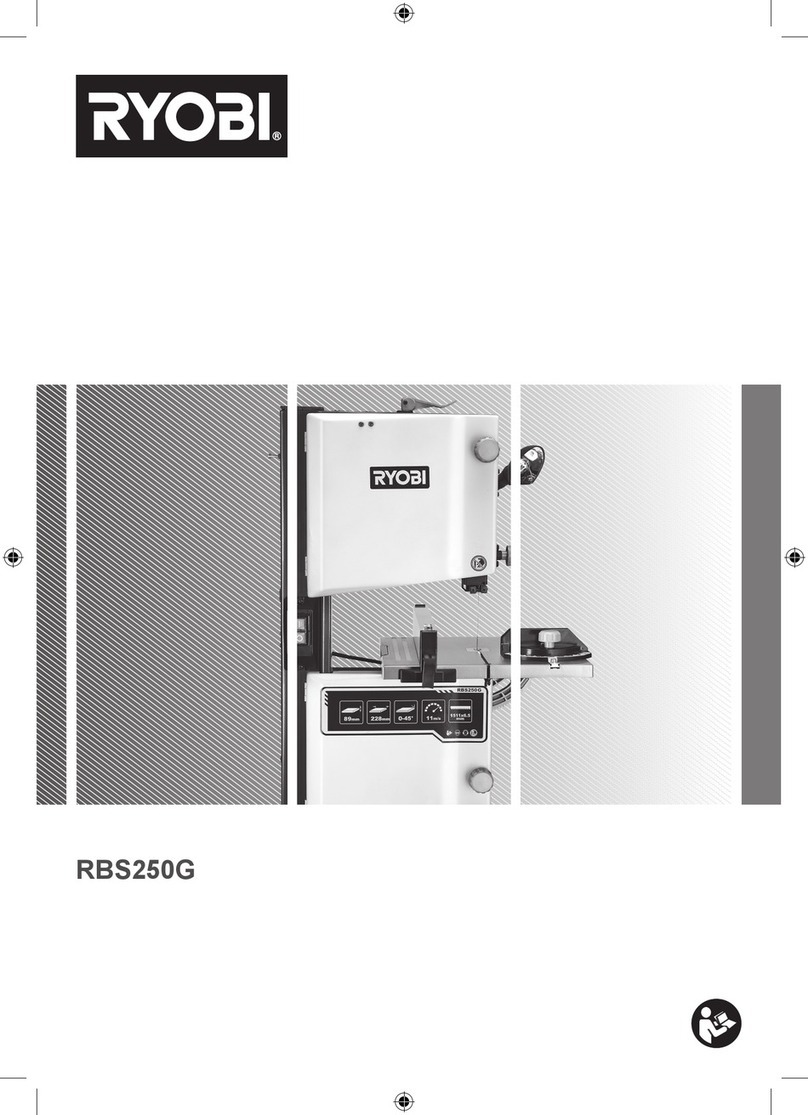
Ryobi
Ryobi RBS250G User manual

Ryobi
Ryobi EWS-1266 Instructions for use

Ryobi
Ryobi TS1552DXL User manual

Ryobi
Ryobi TS1342 User manual
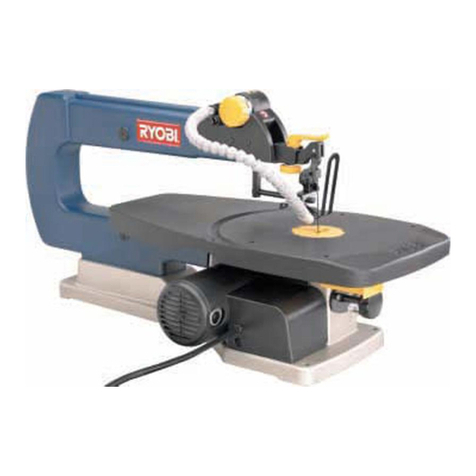
Ryobi
Ryobi SC180VS User manual
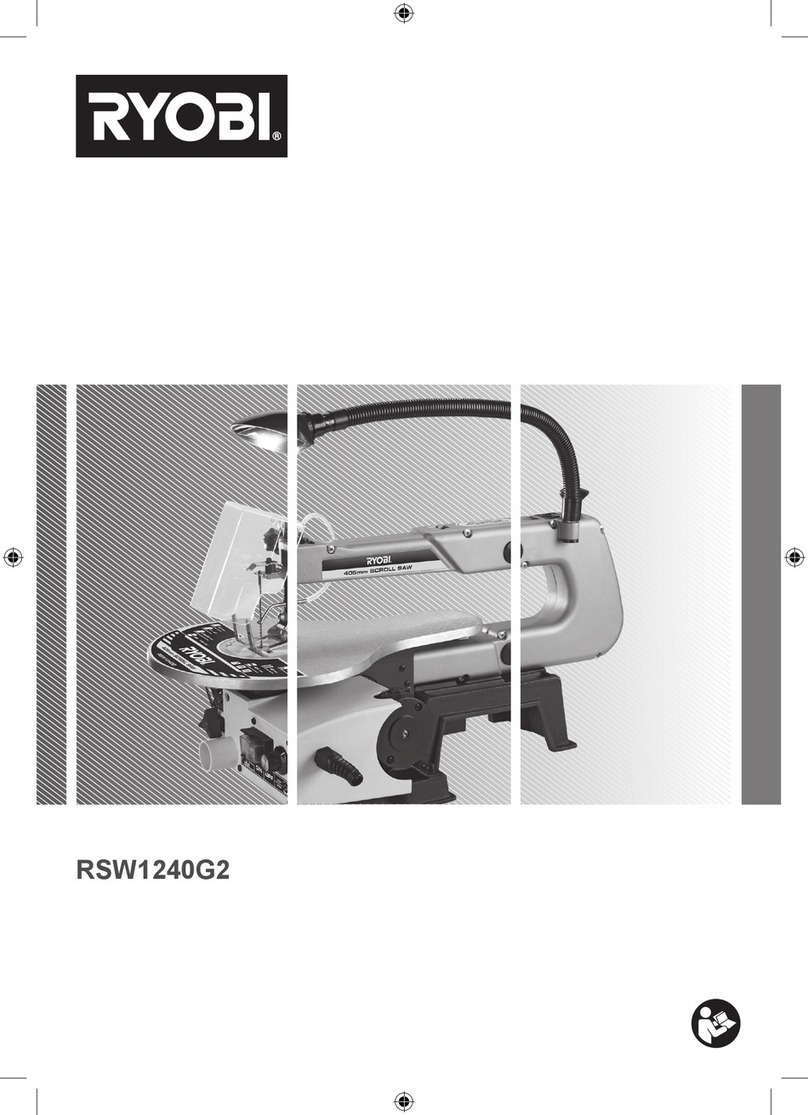
Ryobi
Ryobi RSW1240G2 User manual

Ryobi
Ryobi EMS216L-LSG User manual
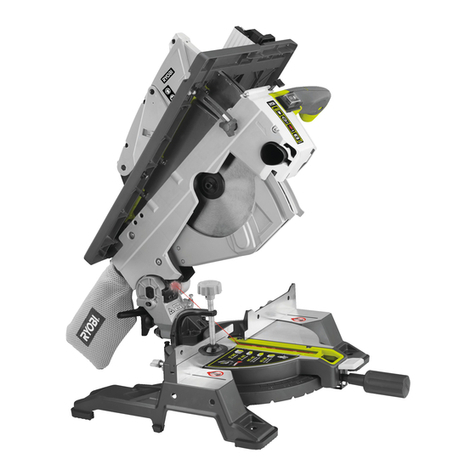
Ryobi
Ryobi RTMS1800 User manual

Ryobi
Ryobi RTS30 User guide
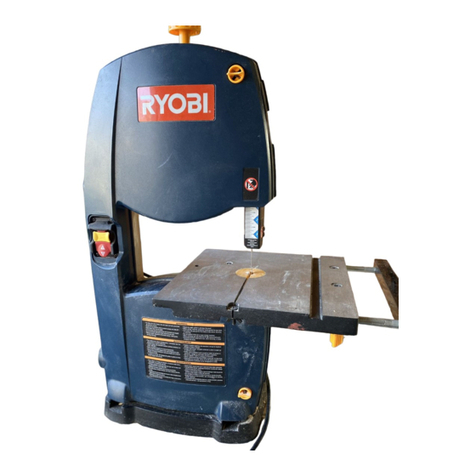
Ryobi
Ryobi BS903 User manual

Ryobi
Ryobi ONE + LTS180M User manual

Ryobi
Ryobi SC162VS User manual

Ryobi
Ryobi RSW1240G User manual
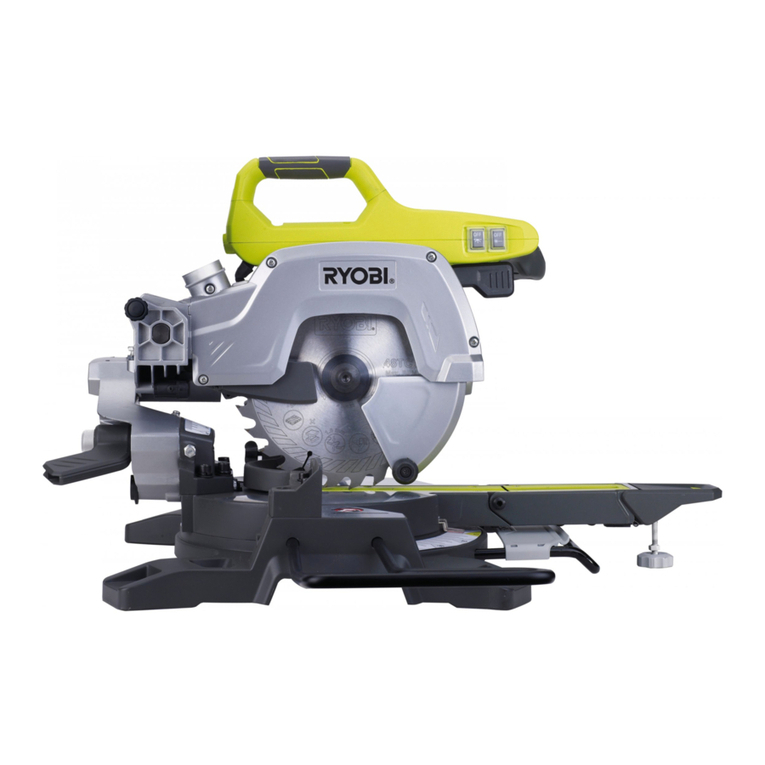
Ryobi
Ryobi EMS216L User manual
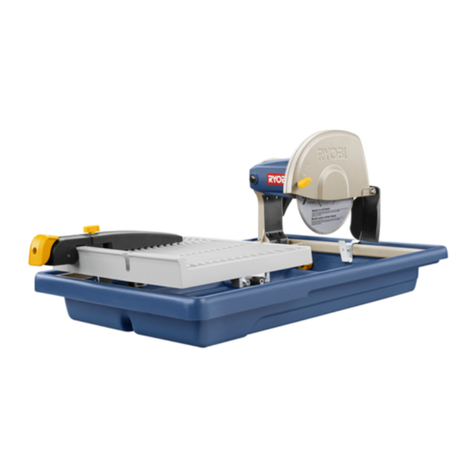
Ryobi
Ryobi WS730 User manual
